THE NORTH WALES COAST RAILWAY NOTICE
BOARD
Hysbysfwrdd Rheilffordd Arfordir Gogledd Cymru
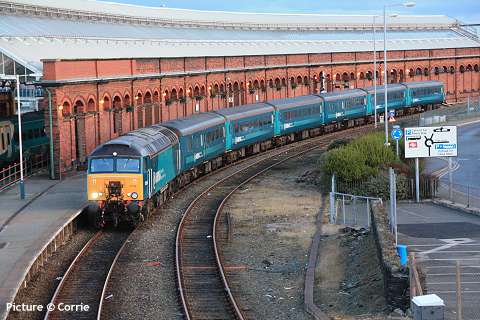
The Rugby Special prepares to leave Holyhead, 13 February;full story
below. Picture by Corrie.
This site is dedicated to all our regular contributors and
supporters, and especially the rail staff of North Wales.
16 February 2010

Editor's
note: a lot more items are on hand - thanks everyone! As many of
these as possible will appear soon, but I thought you'd like to see
these particularly topical stories. -
Charlie
Rugby special weekend 13-14 February
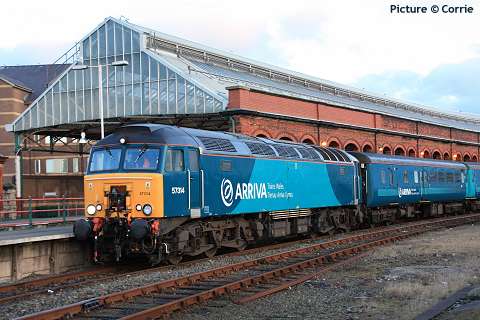
The Wales vs. Scotland rugby match in Cardiff on Saturday 13 February
inspired Arriva Trains Wales to make innovative use of the locomotives
and coaches which are normally only used on Mondays - Fridays. Three
additional standard class coaches (not in use) were attached to the
Friday evening express from Cardiff to Holyhead, where a six-coach
train was made up, the first class / restaurant vehicle being left in
the Holyhead carriage sidings. Above, the train awaits departure from
Holyhead on the Saturday morning. Picture by Corrie.
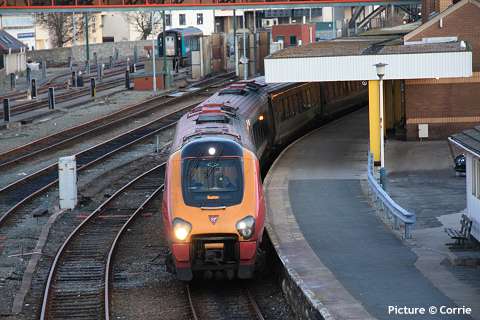
The restaurant car can be glimpsed in the background of this picture of
the 07:55 Virgin Voyager to London in Platform 1 (Corrie).
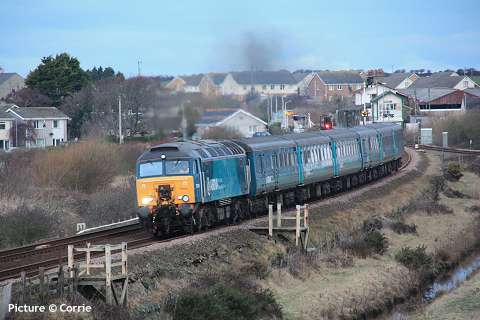
The train left Holyhead at 08:08 calling only at Bangor, Llandudno
Junction, Rhyl, and Chester and arriving at Crewe 10:05, whence depart
it took over the path of the usual 175-operated train 1V77, 09:30
Manchester to Cardiff, the 175 being used to strengthen the next train
from Manchester. Above, the special is seen passing Valley. (Corrie)
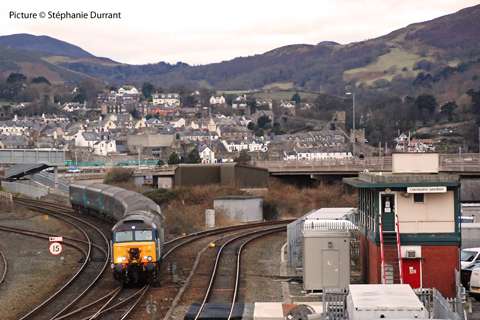
Arriving at Llandudno Junction (Stéphanie
Durrant)
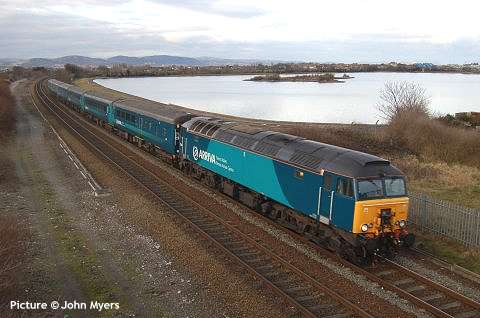
Passing Rhyl Marine Lake (John Myers)
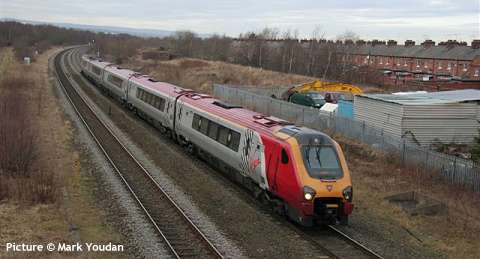
Mark Youdan was in position at
Mold Junction to photograph the rugby special; ahead of it was 221 115 on the 07:55 Holyhead
- Euston ...
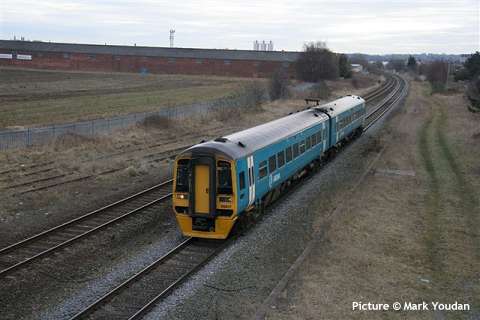
... and westbound 158 837 on
the 07:09 Birmingham International - Holyhead. All the land either side
of the line here was once covered by busy railway installations.
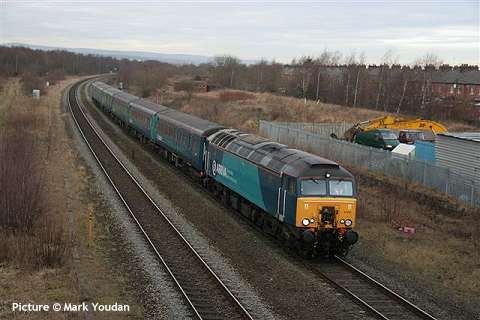
57 314 passes Mold Junction with the special to Cardiff. (Picture by Mark Youdan.) Roger Carvell's
excellent book published in 2009, The Chester to Denbigh Railway, has a
fascinating chapter of railwaymen's reminiscences of this site. (Buy on
line from the Transport
Diversions
Emporium)
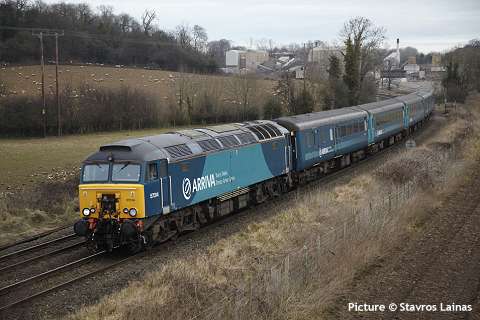
Near Bayston Hill, Shrewsbury (Stavros
Lainas)
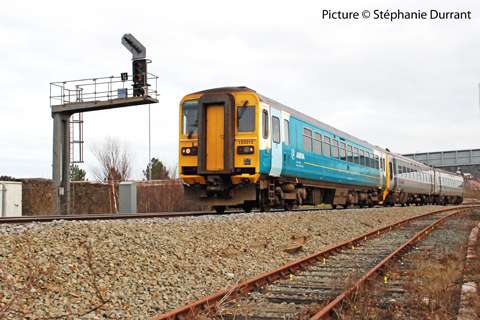
Back on the Coast line, 158 832,
working
the
morning
Shrewsbury
- Holyhead train, seen at Llandudno
Junction by Stéphanie Durrant,
was
strengthened
with
153 312
...
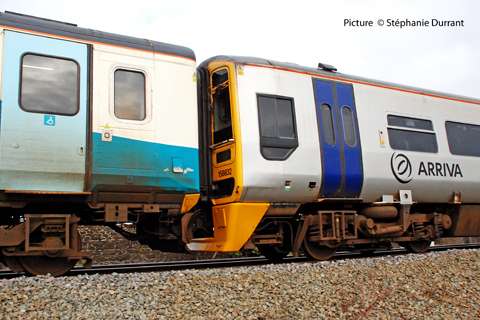
... a measure which reduced the maximum allowed speed of the train from
90 to 75 mph because of the lower speed of the 153, although it seems
to have little effect on running times.
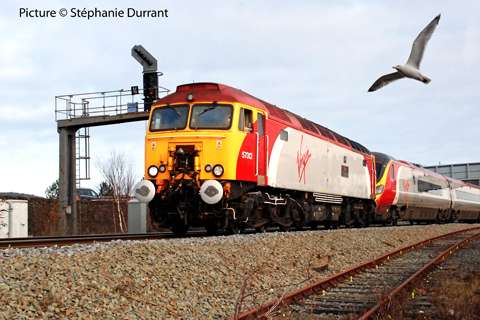
Performing as usual on 13 February the diesel-hauled Pendolino on the
Saturday train from London, train 1D83 08:50 London Euston - Crewe (add
loco 10:35-10:50) arriving Holyhead 12:56, 1A55 14:36 Holyhead - Crewe
(detach loco 16:43-16:57) - arrives London Euston 18:36. Above, the
'down' train. passes the quay siding at Llandudno Junction (Stéphanie Durrant)
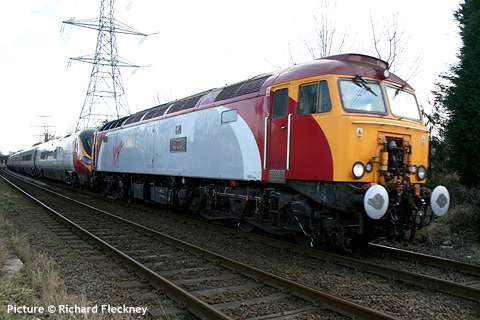
The train consist was 57 312 The Hood + 390 024 Virgin Venturer - above,
approaching Llanfair PG (Richard
Fleckney)
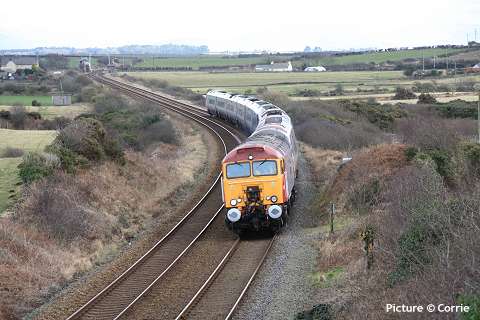
Passing Ty Croes (Corrie)
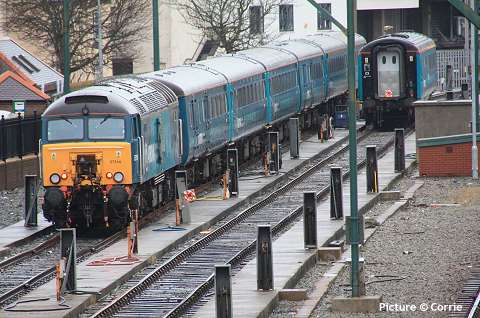
The Arriva train returned to Holyhead after the match (which Wales won
31 - 24 thanks to a 'dramatic last-gasp try by Shane Williams' ) as the
16:51 from Cardiff in the path of a Manchester train as far as Crewe -
above, it stands in the carriage sidings at Holyhead, awaiting
re-marshalling.
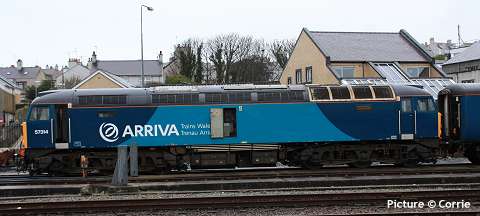
Locomotive 57 314 seemed to
have suffered from its exertions - note the engine room door open
suggesting that fitter's attention is under way.
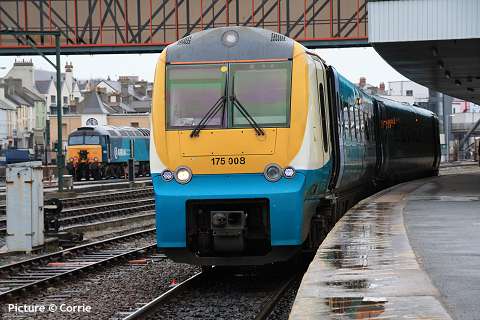
Engineering work on Sunday 13 February meant that trains were running
between Holyhead and Rhyl only. 175
108 (above) awaits its next duty the 13:21 departure to Rhyl. (Corrie)
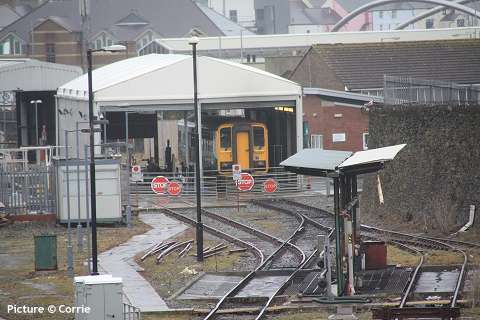
An unusual sight in Holyhead servicing point on 14 February was 153 367 (Corrie)
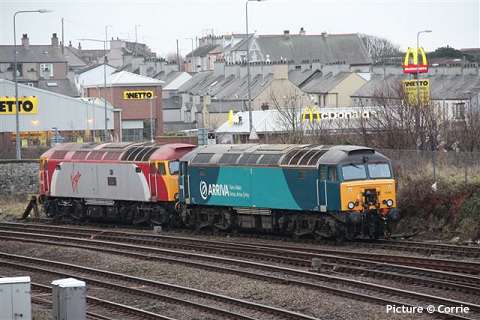
As things transpired, it was 'Game Over' for 57 314 and it failed to
make the Monday morning service to Cardiff. The scene above at Holyhead
just after 08:00 on 15 February saw 57
308 Tin Tin and 57 314 awaiting the return trip to
Longsight; 57 308 had arrived in the very early hours with 57 313 which took over the Cardiff
working. Picture by Corrie.
Changes at Prestatyn - pictures by Bob Greenhalgh
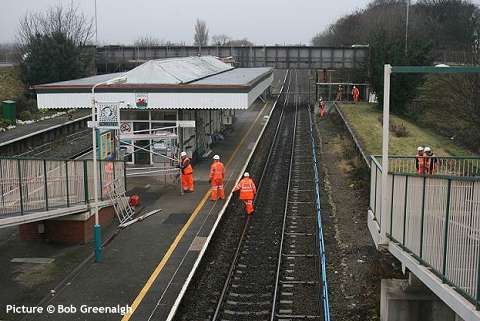
The engineering work of 14 February included the start of work on the
improvements at Prestatyn station. Originally there was a level
crossing on the site of the footbridge, and the station itself was on
the eastern side of this, neared to Chester; the original Chester &
Holyhead Railway building can still be seen. The current road bridge,
seen in the pictures, was built, involving diversion of the road,
around 1897 as part of the project to rebuild the station for four
tracks. At this time the London and North Western Railway footbridge
was provided which carried the right-of-way on the old alignment as
well as serving the four platforms. In the later days of British Rail,
the line became double track again, and the outer platforms were
abandoned leaving just the island platform with a track either side.
The present footbridge with its ramps replaced the old steps-only one.
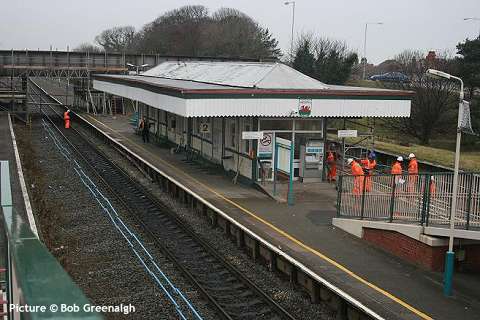
The current project, partially funded by the disability authorities and
Denbighshire council, involves the construction of a temporary
footbridge against the road bridge, which passengers will reach by
walking along the remains of the old platforms. The pictures from 14
February show work under way on preparing for the temporary bridge. The
exiting footbridge will then be removed and replaced by a new one
which, we believe, will have more gentle ramps, and a lift down to the
platform. And 'the improvements will include artwork to be funded by
Denbighshire’s Area Regeneration department.' We look forward to seeing
that.
Cambrian ERTMS - something happens
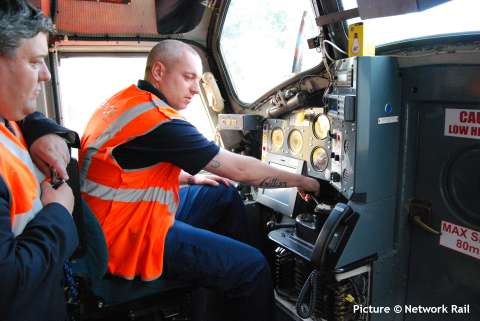
Here's a press release dated 14 February, hot off the Network Rail
website, complete with pictures: above, familiarisation in the cab of a
Class 97/3.
A major Network Rail scheme to improve
the Cambrian line with one of the world’s most advanced signalling
technologies moves a step closer to completion today. For the
first time, the new European Rail Traffic Management System (ERTMS)
will be fully tested on a live railway between Pwllheli and Harlech on
13 – 17 February using Arriva Trains Wales' ERTMS-fitted class 158
passenger train fleet.
The Cambrian line in mid-Wales is the testbed for ERTMS in Britain and
once the scheme is completed, it will become the first railway in the
country to benefit from this new technology. The test run is vital to
determine the readiness of this new system before it is introduced in
phases on the Cambrian line and subsequently across Britain to bring a
more reliable railway, as well as the prospect of more trains to
passengers.
In addition, the success of the exercise will see seven Arriva Trains
Wales drivers become the first in the country qualified to operate
ERTMS-equipped passenger trains. Three signallers from Network
Rail with their new skills in ERTMS will also be pioneering the use of
the new system to manage train movements from the new signalling centre
at Machynlleth.
Rob Carr, senior programme manager, Network Rail said: 'ERTMS is the
next frontier for Britain's railway; it will significantly improve
reliability and capacity on the network. We have carried out a
series of tests on the separate elements of the system but this
exercise is the "full-dress rehearsal" and a vital milestone for this
programme. The test-drive will give this system a thorough and
stringent health-check before we launch it in stages on the Cambrian
line and we hope to commission the first phase on Pwllheli – Harlech by
Spring this year.'
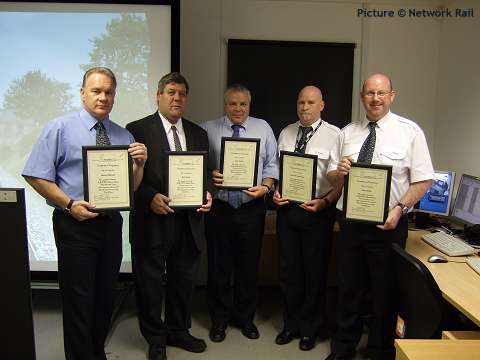
Left to right, with their trainer certificates: left to right, Steven
Beaven, Ron Bailes, Kyle Taylor, Kenneth MacKenzie, and Dave Avery.
Behind them you can see the projection screen of the simulator which
has been created to train drivers in the operation of the system.
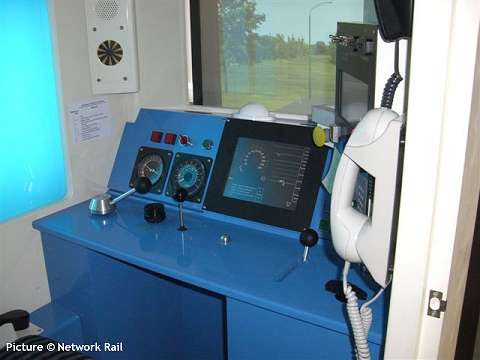
Here's what the cab of the simulator looks like, with the ERTMS display
screen in the centre of the desk. The controls on the desk are (from
left to right) brake, windscreen wiper, horn, AWS acknowledge button,
engine throttle, and forward-reverse switch. This layout is common to
all the Class 15x trains; on the old first-generation units, as we
recall, the throttle was to the laft and the brake to the right.
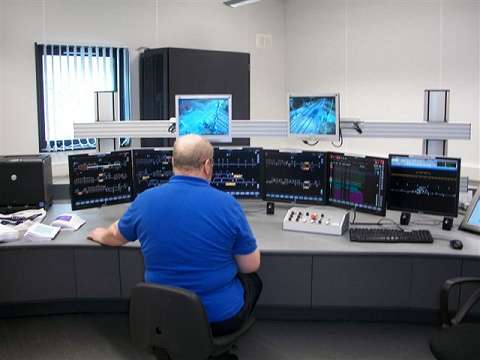
Here's what one of the control centre workstations looks like, with its
array of what looks like Dell computer equipment and the level crossing
CCTV screens above.
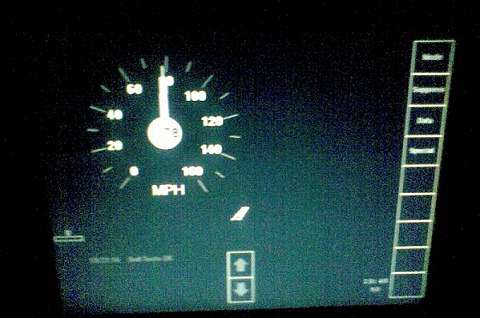
This view, kindly supplied by one of our driver friends, shows what the
driver's screen shows when operating as 'level 0' - when away from the
ERTMS-fitted section, such as between Sutton Bridge, Shrewsbury and
Birmingham. The screen simply acts as a speedometer. Apparently the
indications will change to km/h once on the ERTMS-fitted line: the
system will then have additional elements to indicate to the driver the
appropriate speed to be maintained.
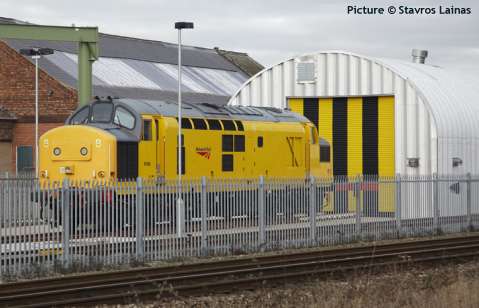
Above, Network Rail's depot outside Shrewsbury, with 97 302, one of its four
ERTMS-project locos which are intended to haul all other trains other
than Class 158s which venture on to the Cambrian lines.
Something of a mystery hangs over the 2010 season of 'The Cambrian'
summer steam service which has been operated in recent times by West
Coast Railways (WCRC). It has been stated that the service will run in
2010, although their
website at the time of writing says 'Timetable and route for 2010
still to be confirmed.' 76079, the locomotive used in previous years,
has been sold to the North Yorkshire Moors Railway, but according to Railway Magazine, another Ian Riley
loco, 'Black 5' 4-6-0 44871,
is to be fitted with ERTMS equipment. It will be certainly interesting
to see how this is achieved, given the amount of equipment that is
required; perhaps there is room under the tender for the doppler radar
equipment, etc.
We hear that the loco is considered overweight for the Barmouth bridge,
due too much weight being on the tender leading axle, so it is proposed
to put a steel former in the coal space to reduce the coal load.
These locos are not ideal for running tender-first, as the there is not
much of a view over the tender, but the type has been used on other
lines with no turning facility, such as Fort William - Mallaig, so it
must considered acceptable.
Presumably one of the Class 97/3 locos will be used as
a rescue loco in case of problems - a role fulfilled by a West Coast
Railways Class 33 in the past.
For more about how ERTMS works, see our 13 November 2009 issue.
Changes at Criccieth - Pictures by Paul Lacey
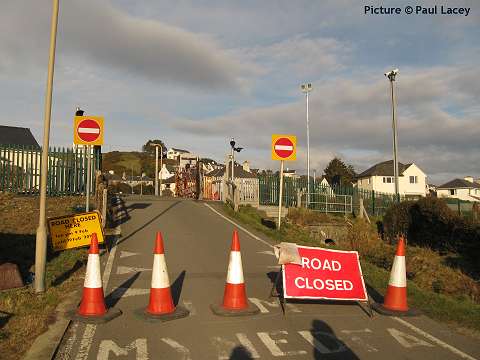
Merllyn Crossing in Criccieth has been one of the three remaining
staffed level crossings, protected by signals, on the Cambrian line. (See our 4 April 2009 issue.)
The
other
manned
crossings
are
the ones at Caersws and Llanidloes
Road near Caersws. In preparation for the new ERTMS signalling system
these are being replaced by full-barrier crossings supervised by
closed-circuit TV and operated from the control centre at Machynlleth.
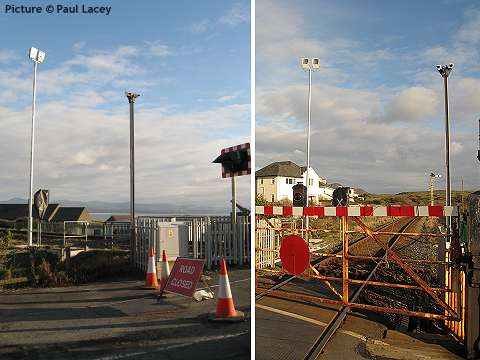
The pictures show the work in progress on 13 February, with the road
and railway closed during the ERTMS tests (see above). The floodlights
and camera masts are in position.
To
the
North
Wales
Coast
home
page : 2010
Archive
: To
the previous Noticeboard































